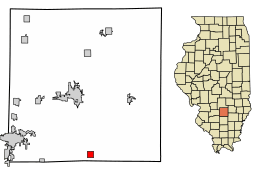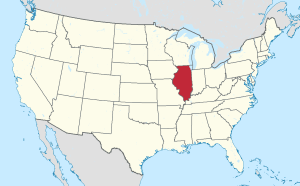Kell, Illinois facts for kids
Quick facts for kids
Kell
|
|
|---|---|

Location of Kell in Marion County, Illinois.
|
|

Location of Illinois in the United States
|
|
| Country | United States |
| State | Illinois |
| County | Marion |
| Area | |
| • Total | 1.00 sq mi (2.60 km2) |
| • Land | 1.00 sq mi (2.60 km2) |
| • Water | 0.00 sq mi (0.00 km2) |
| Elevation | 603 ft (184 m) |
| Population
(2020)
|
|
| • Total | 173 |
| • Density | 172.65/sq mi (66.66/km2) |
| Time zone | UTC-6 (CST) |
| • Summer (DST) | UTC-5 (CDT) |
| ZIP Code(s) |
62853
|
| Area code(s) | 618 |
| FIPS code | 17-39324 |
| Wikimedia Commons | Kell, Illinois |
Kell is a village in Marion County, Illinois, United States. The population was 231 at the 2000 census.
Contents
Geography
Kell is located at 38°29′27″N 88°54′22″W / 38.49083°N 88.90611°W (38.490869, -88.906241).
According to the 2010 census, Kell has a total area of 1.012 square miles (2.62 km2), of which 1.01 square miles (2.62 km2) (or 99.8%) is land and 0.002 square miles (0.01 km2) (or 0.2%) is water.
Kell is located near the divide between the Mississippi and Ohio Rivers. Casey Creek, a tributary of the Big Muddy and Mississippi Rivers, runs through the middle of town. Casey Creek originates just to the north of Kell. The Ohio/Mississippi divide is just east of Kell. The water tower sits atop this prominent ridge. Panther Fork, a tributary of the Little Wabash, Wabash and Ohio Rivers has its origin just over the ridge.
Kell is also located on the divide between the Big Muddy and Kaskaskia Rivers, both tributaries of the Mississippi. The divide between the Casey Creek/Big Muddy Basin and the Kaskaskia Basin is about 1,000 feet (300 m) west of town, over a rise that is barely noticeable.
History
Today Kell is located on Kell Road, a road that serves Kell, but seems to go nowhere, and comes from nowhere. There is an elevator and a rail line there, but these were built long after the settlement was founded. One might therefore ask: why did Kell ever come into existence?
The answer may lie in Kell's location at the junction of the Kaskaskia/Big Muddy/Ohio Divides. Before there were bridges, pioneer roads tended to follow the ridges, or divides, between watersheds. Along these ridges there were only small creeks that could be easily crossed, often without even getting one's feet wet. At the junction of two divides, Kell was a natural intersection for pioneer roads.
Prior to its destruction in the 1811–12 New Madrid earthquakes, Kaskaskia was the capital of Illinois, and the economic center of the Illinois Territory. Fort Vincennes, on the Wabash River, was also an important center. Although these centers were mainly accessible by river, there was also an overland trail between them.
The natural route from Fort Kaskaskia to Fort Vincennes would start by following the Kaskaskia/Big Muddy divide to Kell. The natural route would start east out of Fort Kaskaskia, climbing to the Kaskaskia/Big Muddy divide, somewhere near modern Sparta, Illinois. The modern Nashville Road follows the divide through Coulterville to Nashville. Short segments of the pioneer road appear along the divide between Beaucoup, Richview and Walnut Hill.
The road from Walnut Hill to Interstate Highway 57 is clearly a pioneer road that is following the terrain, rather than the surveyed section lines. At I-57 it becomes the Kell Road, following the modern Section boundaries over flat terrain to Kell.
At Kell, the natural road met the Mississippi/Ohio divide. Beyond Kell there was no natural route along divides to Fort Vincennes: it would involve a detour of more than 100 miles (160 km) to avoid major river crossings. This is probably what George Rogers Clark described as marching over "drownded country" in his conquest of Illinois.
To the east of Kell, there are three routes to Fort Vincennes, all requiring several river crossings. The shortest route would be to go straight to Vincennes along the modern Kell Road. One could also follow the divide two miles (3 km) north to the modern Slap Out Road. Or, one could go about eight miles (13 km) farther north along the divide to the modern U.S. Route 50 at Iuka. George Rogers Clark went all the way to Iuka, and to Xenia, before crossing the drownded country.
Which of these routes was the best depended in part on the weather. In dry weather, the Kell Road had the fewest river crossings. These, however, might be too deep in wet weather, in which case the more northerly routes would have shallower crossings, but more of them.
To the east of Kell, the Kell road follows mostly modern quarter section roads, with occasional stretches of pioneer roads. There are traces of many abandoned towns on the road east of Kell, as though this was once a major road. It joins Slap Out Road near Helms, about nine miles (14 km) east of Kell.
It seems likely that Kell was at one time on the main east/west road between Fort Vincennes and Fort Kaskaskia. This road probably fell into disuse after the destruction of Kaskaskia in 1812, and became more irrelevant after the State Capital was moved to Vandalia in 1820.
The first settler near Kell was Hiram Milburn, who arrived around 1836. Around 1854, he sold out, and founded Dix, Illinois.
Elizabeth Kell (ca. 1890 to ca. 1980) grew up in Kell. She taught school in Mt. Vernon through the 1950s, and was not much given to humor. She claimed that Kell had no name before the railroad came through. She was with her brothers watching workmen paint the new train station. They asked what the children's names were. Upon finding out the children were all named Kell, they painted "Kell" on the sign, and the town had been Kell ever since. John Caldwell (ca. 1925) was raised in Kell and his mother was a Kell. He read from "Memories of the Village of Kell" compiled by Virginia Wilkins (mayor of Kell) at Kell's centennial in 1995. Kell's earlier name was Little Ridge but renamed April 1, 1895 by the U.S. Post Office because another Little Ridge, Illinois existed. Kell brothers learned that an owner of a general store in nearby Foxville spoke to railroad officials about not placing a stop there because he did not want to attract competing stores. Then the Kell brothers (Matthew and Charles) offered to donate land to the railroad for a rail depot, the railroad accepted the offer.
Demographics
| Historical population | |||
|---|---|---|---|
| Census | Pop. | %± | |
| 1930 | 187 | — | |
| 1940 | 216 | 15.5% | |
| 1950 | 193 | −10.6% | |
| 1960 | 194 | 0.5% | |
| 1970 | 173 | −10.8% | |
| 1980 | 283 | 63.6% | |
| 1990 | 213 | −24.7% | |
| 2000 | 231 | 8.5% | |
| 2010 | 219 | −5.2% | |
| 2020 | 173 | −21.0% | |
| U.S. Decennial Census | |||
As of the census of 2000, there were 231 people, 84 households, and 68 families residing in the village. The population density was 228.7 people per square mile (88.3/km2). There were 89 housing units at an average density of 88.1 per square mile (34.0/km2). The racial makeup of the village was 100.00% White.
There were 84 households, out of which 35.7% had children under the age of 18 living with them, 73.8% were married couples living together, 7.1% had a female householder with no husband present, and 17.9% were non-families. 15.5% of all households were made up of individuals, and 11.9% had someone living alone who was 65 years of age or older. The average household size was 2.75 and the average family size was 3.09.
In the village, the population was spread out, with 27.3% under the age of 18, 6.5% from 18 to 24, 28.1% from 25 to 44, 25.1% from 45 to 64, and 13.0% who were 65 years of age or older. The median age was 40 years. For every 100 females, there were 97.4 males. For every 100 females age 18 and over, there were 100.0 males.
The median income for a household in the village was $40,909, and the median income for a family was $41,719. Males had a median income of $31,806 versus $21,250 for females. The per capita income for the village was $17,002. None of the population or families were below the poverty line.
See also
 In Spanish: Kell (Illinois) para niños
In Spanish: Kell (Illinois) para niños

